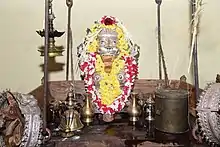| Jumadi | |
|---|---|
abundance | |
 | |
| Affiliation | Grāmadevatā Kuladevata Tutelary deity tree deity |
| Abode | world |
| Mantra | Jumadi Mantra |
| Weapon | sword Ghanta |
| Mount | Buffalo or Elephant |
| Texts | Folk religion Dravidian folk religion Animism |
Jumadi is an androgynous deity worshipped in the Buta Kola folk tradition. The Buta Kola cult is popular among the Tuluva ethnic people in the coastal districts of Karnataka, India.
Mythology
Jumadi is considered a deity of heavenly origin who descends to the Tulunadu region to receive worship from the people.
The various myths prevalent in the region describe the deity's insatiable thirst and the establishment of its cult among the dominant Bunt community. The deity's cult is further exalted by the worship it receives from the Chowta royal family of Moodabidri. The Royal House of Chowta worships Jumadi at a shrine inside the Chowtara Aramane Palace.[1]
The deity's association with the ruling class Bunts gives it the epithet "Rajan-Daiva" (Deity of the Rulers). The myths pertaining to Jumadi are oral in nature and are recorded in distinctive Tulu folk songs called paddanas.[2]
The paddanas record the various adventures and legends of the deity. They also record the various forms and names of the deity such as Kanteri Jumadi (Jumadi worshipped by the Bunt Feudal Lords, Kantanna Adhikari and Devu Poonja), Marlu Jumadi (the wild form of the princely Jumadi), and Sarala Jumadi (Jumadi worshipped by a thousand households).
The legend of Jumadi describes an Asura named Dhumasura, who had a boon by which only an Androgynous person could kill him. He killed and ate many humans, resulting in everyone praying to Lord Shiva and Goddess Parvati, who then descended on Earth to kill the demon. On their way Parvati felt hungry and Shiva tried to satisfy her through various means, but she was not satisfied by them at all. At last Shiva offered himself and ordered Parvati to swallow him. As Parvati swallowed him. Shiva didn't reach beyond Parvati 's throat, due to which the face of Lord Shiva appeared with a moustache, and below the neck was the body of Parvati. This androgynous form of Shiva and Parvati killed Dhumasura, because of which they also got named Dhumavathi (not to be confused with Dhumavati Mahavidya.)
See also
References
- ↑ Brückner, Heidrun (2009). On an Auspicious Day, at Dawn: Studies in Tulu Culture and Oral Literature. Otto Harrassowitz Verlag. p. 67. ISBN 978-3-447-05916-9. Retrieved 29 December 2011.
- ↑ Kamila, Raviprasad. "Kantheri Jumadi pad-dana in English". The Hindu. Retrieved 5 October 2017.